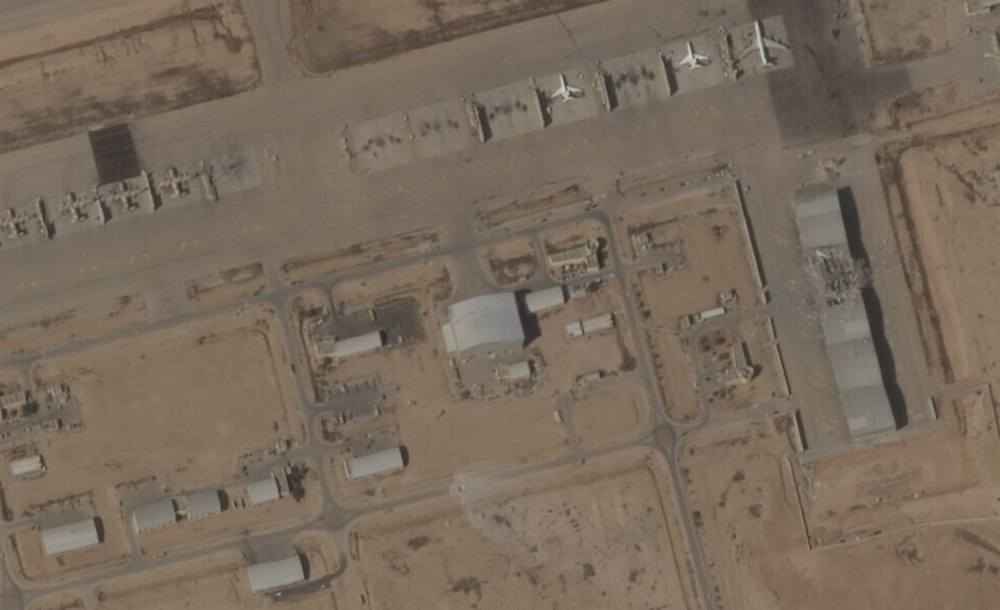Devastating phase after Iran ability to breach 'greatest air defenses'
"Israel" initially claimed it minimized the attack's effects, but subsequently conceded that numerous military locations were directly hit.
-

A satellite photo of "Israel's" Nevatim airbase after Iran's missile attack appears to show damage to a hangar roof on October 2, 2024. (Planet Labs PBC via AP)
A week after Iran launched Operation True Promise 2, the entire scope of the assault is only now becoming clear, The Telegraph reported.
Experts are desperately attempting to determine how - and if - "Israel" can protect itself from more rounds of rockets if the Middle East struggle further escalates.
Meanwhile, Haaretz reported that Iran is capable of continuing a long and destructive war against "Israel" while the latter, already exhausted after a year of war, stands small and weak compared to the Islamic Republic.
Operation True Promise 2 saw Iran launching at least 200 ballistic missiles against Israeli military and intelligence facilities across the occupied Palestinian territories.
One video showed at least nine missiles striking military buildings in "Israel", and detailed testimonies later revealed that many more had broken through.
Dr. Yehoshua Kalisky, Senior Researcher at INSS, stated that Iran's objective was to "saturate the air defense system" by firing an unprecedented 180 missiles simultaneously.
"The idea is to shoot down the missile as far away from Israel as possible, preferably over the enemy's territory," Kalisky told The Telegraph. If it fails, the next levels prepare to fire down the missiles as their height drops.
According to experts, the footage circulated on social media implies that "Israel" may not have enough air defense troops or interceptors to deal with such a massive bombardment.
Fabian Hoffman, a missile expert and PhD research fellow at the Oslo Nuclear Project, explains that the clips showcasing Iran's strikes clearly demonstrate the "extraordinary speed in real time, some 600/700m per second, they are incredibly fast."
All of Iran's missiles were "hypersonic in essence until they re-enter the atmosphere and are slowed down," he explained.
"Israel" initially claimed it minimized the attack's effects, but subsequently conceded that numerous military locations were hit.
Planet Labs' satellite picture subsequently indicated that the Nevatim Air Base had been damaged in 30 distinct locations, causing damage to hangars and structures.
A big missile crater was also discovered near the Israeli intelligence headquarters of Mossad in Glilot, north of Yafa (Tel Aviv).
It is estimated that almost two dozen rockets penetrated air defenses. Twenty missiles attacked the Nevatim air base, while three hit the Tel Nof facility in central "Israel".
Kalinsky stated that it looked like the Arrow system struck the engines of some of the missiles, but they continued to fly and finally fell to the ground.
"Israel" has been the target of a succession of smaller-scale strikes since last October. Experts are especially concerned about the increase in drone assaults, which have exposed possible flaws in "Israel's" Iron Dome security system.
Hundreds of drones from Iran, Iraq, Yemen, Lebanon, and Syria have claimed lives and caused major damage, frequently flying at low altitudes to avoid detection. Notably, a drone covered a distance of 2,000 kilometers from Yemen to hit a residence in Yafa (Tel Aviv,) killing a settler. Security experts worry that a concerted missile strike by Iran and Resistance factions might overwhelm "Israel's" defenses, resulting in massive civilian fatalities.
Kalinsky cautioned that even an indirect attack might cause substantial damage to infrastructure due to strong shockwaves.
Read more: Many Israeli F-35 jets destroyed in Operation True Promise II: IRGC

 3 Min Read
3 Min Read








